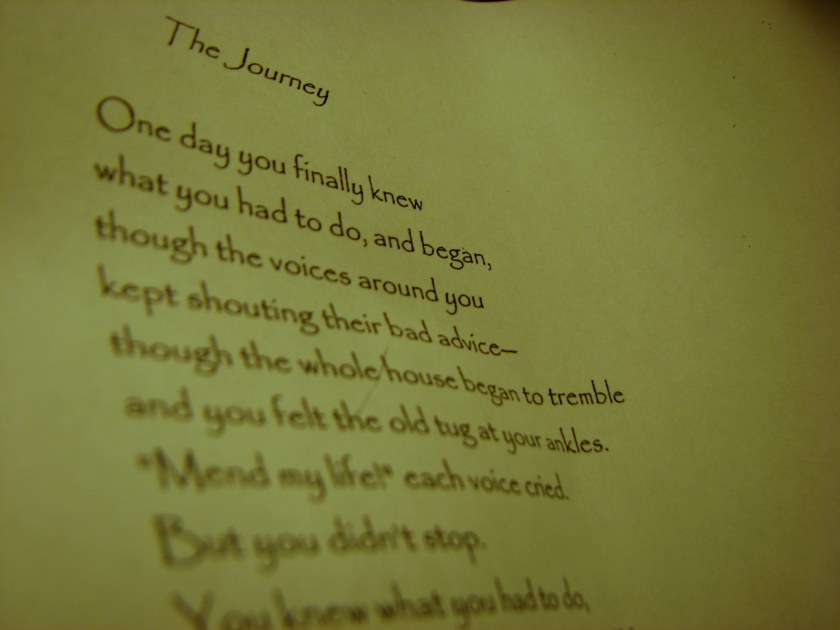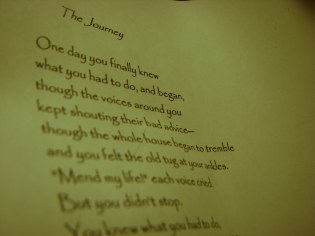
Favorite Quotes on Writing

Writing Down the Bones Natalie Goldberg
Why practice?
“This is the practice school of writing. Like running, the more you do it, the better you get at it. Some days you don’t want to run and you resist every step of the three miles, but you do it anyway. You practice whether you want to or not. You don’t wait around for inspiration and a deep desire to run . . . But you run regularly, you train your mind to cut through or ignore your resistance. You just do it. And in the middle of the run, you love it. When you come to the end, you never want to stop. And you stop, hungry for the next time. (11)
Don’t hold back.
First thoughts have tremendous energy. It is the way the mind first flashes on something. The internal censor usually squelches them, so we live in the realm of second and third thoughts, thoughts on thought, twice and three times removed from the direct connection of the first fresh flash. For instance, the phrase “I cut the daisy from my throat” shot through my mind. Now a second thought, carefully tutored in 1 +1 = 2 logic, in politeness, fear and embarrassment at the natural, would say, “That’s ridiculous. You sound suicidal. Don’t show yourself cutting your throat. Someone will think you are crazy.” And instead, if we give the censor its way, we write, “My throat was a little sore, so I didn’t say anything.” Proper and boring. (9)
…You must be a great warrior when you contact first thoughts and write from them. (10)
Winter’s Tale Mark Helprin
Why to write when you’re not sure what you want to say:
All great discoveries…are made as much from doubt as from certainty and the two in opposition clear the air for marvelous accidents.
Encouragement to keep a Commonplace Book
The New York Times
William Cole
The compiler of a commonplace book is on his/her own; she can put in anything that appeals to her: aphorisms, poems, parts of poems, newspaper clippings, song lyrics, bits of humor, overheard conversations — anything that has struck her as exciting, that she has found stimulating, odd or amusing.
The key word for the commonplace book is “annotated.” It is not just an anthology; the compiler … tells what the passages have led her to think about. A piece of prose, a poem, an aphorism can trigger the mind to consider a parallel, to dredge something from the memory or perhaps to speculate with further range and depth on the same themes.”
Ralph Waldo Emerson
Make your won Bible. Collect all the words and sentences that in your reading have been like a blast of triumph.
The Writer’s Journey
Writing With Both Sides of the Brain
Henriette Anne Klauser
Separating the Artist and the Editor
Then there is the unfettered side of you, where inspiration and rhythm reside. Credit this side of you for your color and cadence and style, for fluency and confidence–and for those little gems of ideas that creep in often unannounced at the quiet moments. This side would be Ariel, Caliban’s foil, the symbol of freedom and flight . . . unlock the Ariel part of you and to train yourself to keep Caliban quiet until called upon to comment . . . (5)
Remember, the key to writing fluently is to separate writing from editing. Rapidwriting–letting the words spill out without stopping to critique or correct or rearrange–is one dependable way to keep the two functions apart. When you edit and write at the same time, the result is often a disaster… Rapidwriting is sometimes called nonstop writing or freewriting. As all of its names suggest, it is a method of writing in a flowing way without stopping to reread, to evaluate. It is a way of holding Caliban at bay while giving Ariel complete freedom to tap into some of your most creative ideas. (15)
On the Progress Log
They say that it took Edison over a thousand tries before he perfected the filament in a light bulb so that the light bulb would stay on. One time he was asked if that was discouraging–to try a thousand times and fail. “Never thought of it as failure,” he answered. “It was only a thousand ways not to make an electric light bulb.”
I want you to establish a notebook called the Progress Log to turn a light on in your mind and discover your personal writing pattern … A log records a journey and progress implies a moving forward … a specific notebook where you chart your course and your progress as a writer. And you make an entry every day. (21-22)
Interview with Roald Dahl at the end of Fantastic Mr. Fox
How do you keep the momentum going when you are writing a novel?
One of the vital things for a writer who’s writing a book, which is a lengthy process, is how to keep the momentum going. It is the same with a younger writing an essay . They have got to write four or five or six pages. but when you are writing for a year, you go away and you have to come back. I never come back to a blank page; I always finish about halfway through. To be confronted with a blank age is not very nice.
But Hemingway, a great American writer taught me the finest trick when you are doing a long book, which is, he simply said in his own words, “When you are going good, stop writing.” And that means that if everything is going well and you know exactly where the end of the chapter’s going to go and you know just what the people are going to do, you don’t go on writing until you come to the end of it, because when you do, then you say, well, where am I going to go next?
And you get up and you walk away and you don’t want to come back because you don’t know where you want to go. But if you stop when you are going good, as Hemingway said … then you know what you are going to say next. You make yourself stop, put your pencil down and everything and you walk away. And you can’t wait to get back because you know what you want to say next and that’s lovely and you have to try to do that. Every time, every day all the way through the year. If you stop when you are stuck, you are in trouble!
If You Want to Write
Barbara Ueland
On Keeping a journal/Diary
I have kept a slovenly, headlong, helter-skelter diary for many years. (127) Yes, from writing a diary I am sure that I have learned things . . . I don’t think the learning process would have moved on so well, if I had not written down today’s minute revelation. And that is why, if you want to write, you might try it. (132)
Remember how wonderful you are
Think of yourself as incandescent power, illuminated perhaps and forever talked to by God and his messengers. Remember how wonderful you are, what a miracle! (162)
The Modern Library Writer’s Workshop
Stephen Koch
On Making Character’s Live
By far the best way to develop a character is to tell that character’s story. And by far the best way to develop a story is to tell us what the characters do . . . action consists of human interchange . . . Dramatic exchange is the thing–it is the only thing–that makes characters visible, even to their authors. Like a hunter peering into the leafy dusk, your imagination will never spot its quarry until it moves.
Ray Bradbury advises that you “find a character like yourself, who will want something or not want something, with all his heart. Give him running orders. Shoot him off. Then follow as fast as you can go. The character, in his great love, or hate, will rush you through to the end of the story.”
Books
For an expanded list, with annotations, see my blog: katadventures.com/booklist
Dillard, Annie. The Writing Life. New York: Harper & Row, 1989.
Goldberg, Natalie. Writing down the Bones: Freeing the Writer within. Boston: Shambhala, 1986.
Gornick, Vivian. The Situation and the Story. New York: Farrar, 2001.
Heard, Georgia. Writing Toward Home. Portsmouth, NH: Heinemann, 1995.
Klauser, Henriette Anne. Writing on Both Sides of the Brain. New York: Harper & Row, 1986.
Koch, Stephen. The Modern Library Writer’s Workshop. New York: The Modern Library-Random, 2003.
Prose, Francine. Reading Like a Writer. New York: HarperCollins, 2006.
